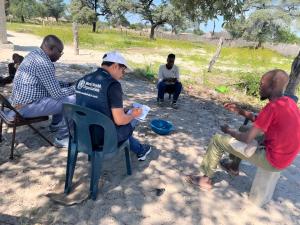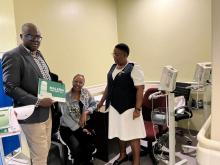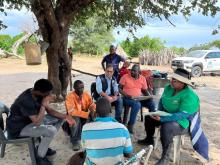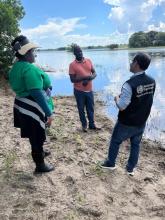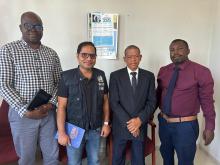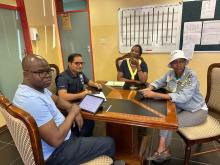Tackling the Malaria surge: WHO supports Botswana’s coordinated response to 2025 outbreak
In response to a recent upsurge in malaria cases, the Ministry of Health in Botswana, supported by the World Health Organization (WHO) and the Roll Back Malaria (RBM) initiative, has launched an emergency response to contain the outbreak and protect vulnerable communities.
Cases have surged since March 2025, reversing years of hard-won progress in controlling the disease. Triggered by unusually heavy rainfall, the outbreak created widespread mosquito breeding grounds, leading to a sharp rise in infections across both traditionally endemic and previously malaria-free districts. As of end of May 2025, more than 2,311 malaria cases had been confirmed, including nearly 100 severe infections and eight deaths, marked increase compared to the same period the previous year. The hardest-hit districts include Okavango Ngami, Chobe, Tutume, and Boteti, with new cases also recorded in urbanized localities such as Gaborone, Francistown, and Mahalapye, as well as previously malaria-free districts like Ghanzi. This surge marks a setback for Botswana, which had successfully reduced malaria cases by 93% by 2021. “We lost our guard not when the country received above-normal rainfalls, but when implementation of preventive interventions, mainly vector control, fell below par for achieving impact on transmission,” says Dr Tebogo Madidimalo, WHO Botswana’s malaria focal person.
Earlier this year, a multidisciplinary team of national and international experts from WHO visited three of the hardest-hit districts, Okavango Ngami, Ghanzi, and Chobe. The team visited health facilities, engaged with stakeholders, and evaluated the local response. WHO supported coordination efforts in hotspot districts. In Ghanzi, a district that had been malaria-free since 2010, vector control measures were reinstated, including indoor residual spraying (IRS), distribution of long-lasting insecticidal nets (LLINs), and biolarviciding (the regular application of biological insecticides to water bodies) in affected villages.
In Seronga village, within Okavango District, WHO addressed treatment adherence challenges, limited diagnostic supplies, and poor community uptake of nets. The findings of the assessment assisted the district team to address all the issues. Engagement with traditional leaders (Dikgosi) helped boost support for IRS and improve use of prevention tools. WHO teams also reached remote cattle posts in Rukonga, where mobility and stagnant water increased malaria risk. In Xakao’s Gowa Secondary School, which became an outbreak hotspot in February 2025, overcrowding, damaged infrastructure, and poor sanitation were identified as key drivers. A targeted response, including reactive drug administration and LLIN distribution, helped reduce case numbers. The evidence on the drastic decline of cases in certain hotspots underscores the importance of administration and LLIN distribution.
During a debrief with the Ministry of Health and stakeholders, Dr Madidimalo emphasized the opportunity for course correction: “With unity of purpose, we can overcome this surge in cases and regain our momentum toward malaria elimination, which is within reach for Botswana,” he said. Dr. Dhruv Pandey, WHO technical focal point for tropical and vector-borne diseases in the South African hub countries (MCAT), highlighted the urgent need to prioritize efforts toward eliminating malaria, adding that timely detection, coordinated response and community engagement are critical to containing malaria outbreaks. “Strengthening surveillance and ensuring rapid access to diagnosis and treatment remain our top priorities in Botswana. Botswana, as part of WHO E-25 initiatives, stands out as a trailblazer in the drive towards malaria elimination,” he explained.
Vonai Chimhamhiwa, RBM Sub-Regional Coordinator for East & Southern Africa, stressed the need for collective responsibility: “Elimination is possible, but only if we treat this as a societal mission. Everyone has a role, from the community to policymakers. ”Structural challenges remain. In remote villages, traditional homes made of reeds and grass complicate spraying efforts and offer ideal resting places for mosquitoes. Improper installation of nets also limits their effectiveness.
Despite these setbacks, Botswana’s coordinated response, led by the Ministry of Health’s National Malaria Programme and the Botswana Public Health Institute, and supported by WHO, RBM, ALMA, and other partners, signals a renewed determination to halt transmission and restore progress toward malaria elimination.
